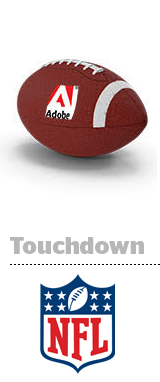
National Football League players train during the offseason – and so does the NFL’s marketing team.
From January through July, Aaron Jones, the NFL’s director for club and international marketing, is busily stress-testing his marketing stack and experimenting with new tools to prepare for August and September, when it’s all about activation.
“Then, it’s like Black Friday for us,” Jones said.
Jones has been testing a feature within Adobe Audience Manager called trait recommendations, which became generally available on Tuesday and uses machine learning to recommend attributes that marketers can add to audience segments in real time to make them perform better.
For the NFL, that means identifying specific qualities that help predict team affinity and determine a person’s level of enthusiasm. Because there are fans – and there are fanatics, and it makes sense for the NFL to recognize the difference in its segmentation strategy.
Jones worked with Adobe to build models for avidity and team personas, which the NFL tested during the last offseason using digital marketing creative and onsite personalization. Targeting team-based ads drove a 90% increase in visitors to the NFL GamePass website over generic NFL ads.
But personalization can fumble when advertisers try to bring the segments they crafted within their demand-side platform into walled garden environments and social networks, where marketers can either use the walled garden’s pixel to build retargeting segments or upload an email list a la custom audiences.
Neither is ideal, said Matt Skinner, a product marketing manager for Adobe Audience Manager.
“You can do all of this great segmentation in your DMP and connect those segments with activation touchpoints across the open web and within personalization engines,” Skinner said. “But there’s been a sort of unspoken understanding that it doesn’t stay consistent when you get them into the walled gardens.”
Adobe’s answer is a tool called people-based destinations, which is set to enter beta in May. It allows marketers to combine their first-party CRM data with online DMP data to inform their paid social advertising. Adobe declined to share which walled gardens it’s planning to partner with but noted that it’s been talking to all the usual suspects.
The NFL, which has been an Adobe shop for the last five years or so, plans to test the feature when the beta opens.
Jones is always looking for new ways to get creative with his segmentation and touch new audiences, he said.
For example, it’s valuable to target people who previously played Fantasy Football on Facebook. But it could be more effective to develop segments of people who previously played Fantasy Football, watched a Fantasy Football video or also visited other Fantasy Football content to see which group is more likely to buy a GamePass or take some other action.
“We could add additional segments and optimize our bids on these platforms,” Jones said. “If we can provide additional context, we can be more intelligent in how we market there.”
But Jones also wants to get smart beyond the walled gardens. He and his team recently started working with LiveRamp to activate a database for non-social programmatic buying, and he’s ramping up that effort during this offseason.
He’s also on the hunt for NFL-related data and collaborations with anyone who has intel about fans that could feed his avidity models, including league broadcasters, advertisers or social platforms.
On that score, the NFL is already partnering with Ticketmaster and has a few other potential partners in the works.
“I’m putting the Bat-Signal out there – we will talk to anyone who has digital NFL data, and I’m willing to share the data I have from all of our club platforms,” Jones said. “I’m willing to do anything I can to improve.”
This post was syndicated from Ad Exchanger.


More Stories
Creativity shines
Hilton Uses Social Listening to Showcase ‘Superior’ Stays
Spring surge of members for World Out of Home